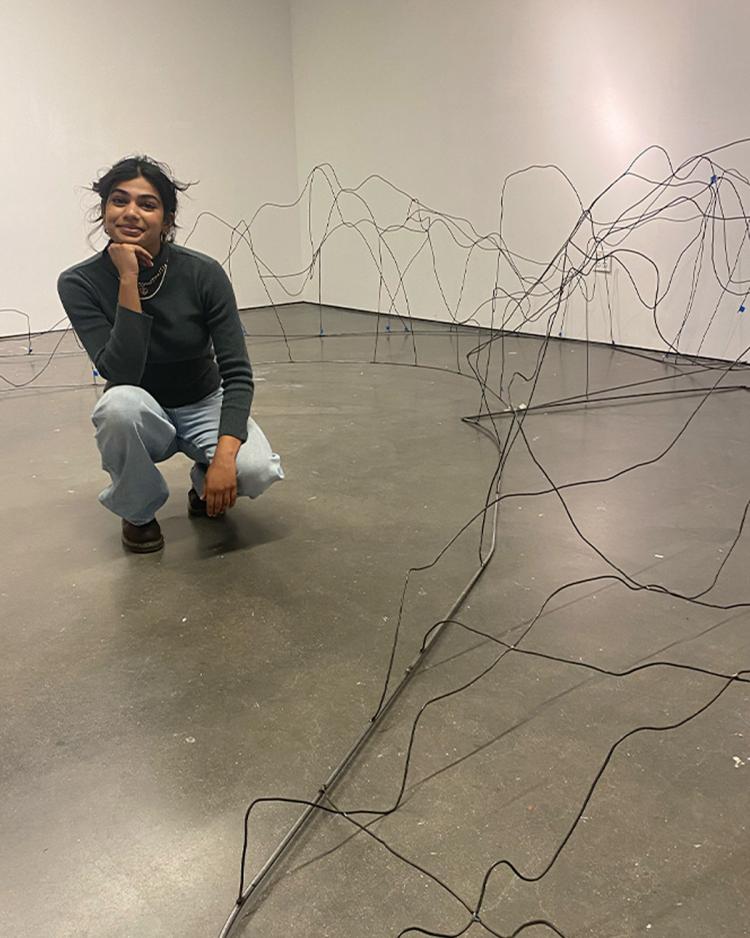Artist vivifies the pain, diaspora and tragedy of Kashmir
Shloka Dhar, who majored in art practices and molecular, cellular and developmental biology, is the College of Arts and Sciences’ outstanding graduate for fall 2022
Shloka Dhar began her studies at the University of Colorado Boulder with a plan: take a pre-med track to become a doctor. Four-and-a-half years later, she’s chosen a path that better reflects who she is and where she is from.
Last week, Dhar graduated with a BA in molecular, cellular and developmental biology, along with a Bachelor of Fine Arts in art practices, summa cum laude. She also has been named the outstanding graduate of the College of Arts and Sciences for fall 2022.

At the top of the page: Shloka Dhar smiles in front of her thesis project, which is titled Mõaj. Above: Before completion, Dhar poses next to her project's metal framework, which reflects the topography of the Himalayas in Kashmir, her family homeland.
What changed, Dhar told fellow honors graduates last week, was that she realized her interests were broader than medicine. Dhar has worked in a lab studying muscle stem cell regeneration in mice. Although that was exciting work, Dhar said, she felt she was not doing justice to who she is as a person.
“For as long as I have remembered, I have always loved biology, and I have always loved art,” she said. “The rest of the world thought art and science are different career paths, and for a moment, I believed them.”
“But I did not want to settle for one or the other, because I truly believe that they are intertwined,” she continued. Her honors thesis in sculpture thus combined the two, exploring ideas of genetic memory, preservation, loss, physical displacement and genocide.
Dhar was born in Bokaro Steel City in India, an industrial center, but her roots are in Kashmir, the disputed war-ravaged territory at the northern juncture of India and Pakistan.
Kashmir, Dhar notes, “is a war zone that I have never been able to visit, and now I am a citizen of a country that I feel does not want me. I do not belong where I am now, stuck in a liminal space. My art documents my explorations through this in-betweenness, of expeditions through my personal identity and out into my interactions with the physical world.”
Dhar’s mother fled the Kashmiri Pandit Genocide of 1990, which was conducted by Islamic extremists, she notes in her thesis. Legally, Dhar is an Indian immigrant who has American citizenship. “However, I really consider myself a displaced Kashmiri.”
Dhar reflects that her identity is constructed of many parts, “many of which seem to clash.”
“The identity I grew up with is disintegrating, and in the midst of attempting to reconstruct it, I ask myself, ‘How can I be a Kashmiri when there is no more Kashmir?’”
Her thesis project, titled Mõaj, is “a continuing discourse about my experiences of physical and psychological displacement, genetic memory, a reclamation of the land, and reconnection with my ancestors,” she writes.
Mõaj is a sculpture constructed of more than 550 feet of steel and traditional Indian fabric. It reflects the Himalayan topography of Kashmir, and it “embodies the heaviness of these ideas,” she states.
Through her art, she says, “I can visually understand the nature and extent of the psychological pain and intergenerational trauma present in my body. It is given a physical form that persistently highlights the beauty of my culture so that I am able to acknowledge the pain.”
My art is my most successful method of communication, and the most important message I want to communicate is that I am here. I persist not only despite my cultural history, but because of it.
“Both pain and beauty must be present so that neither is gone unappreciated. My art is my most successful method of communication, and the most important message I want to communicate is that I am here. I persist not only despite my cultural history, but because of it.”
Yumi Janairo Roth, a professor in sculpture and post-studio practice who was Dhar’s thesis advisor, says that she and fellow faculty member Richard Saxton are "incredibly proud of Shloka.”
Roth adds: “Mõaj is a remarkable work that, in many ways, is semesters in the making, bringing together issues related to the Kashmiri diaspora, identity, epigenetic memory and community that Shloka has been exploring for a while. We're excited for what the future holds for her.”

